Abstract
This study describes the use of an operant methodology to assess functional relationships between self-injury and specific environmental events. The self-injurious behaviors of nine developmentally disabled subjects were observed during periods of brief, repeated exposure to a series of analogue conditions. Each condition differed along one or more of the following dimensions: (1) play materials (present vs absent), (2) experimenter demands (high vs low), and (3) social attention (absent vs noncontingent vs contingent). Results showed a great deal of both between and within-subject variability. However, in six of the nine subjects, higher levels of self-injury were consistently associated with a specific stimulus condition, suggesting that within-subject variability was a function of distinct features of the social and/or physical environment. These data are discussed in light of previously suggested hypotheses for the motivation of self-injury, with particular emphasis on their implications for the selection of suitable treatments.
Full text
PDF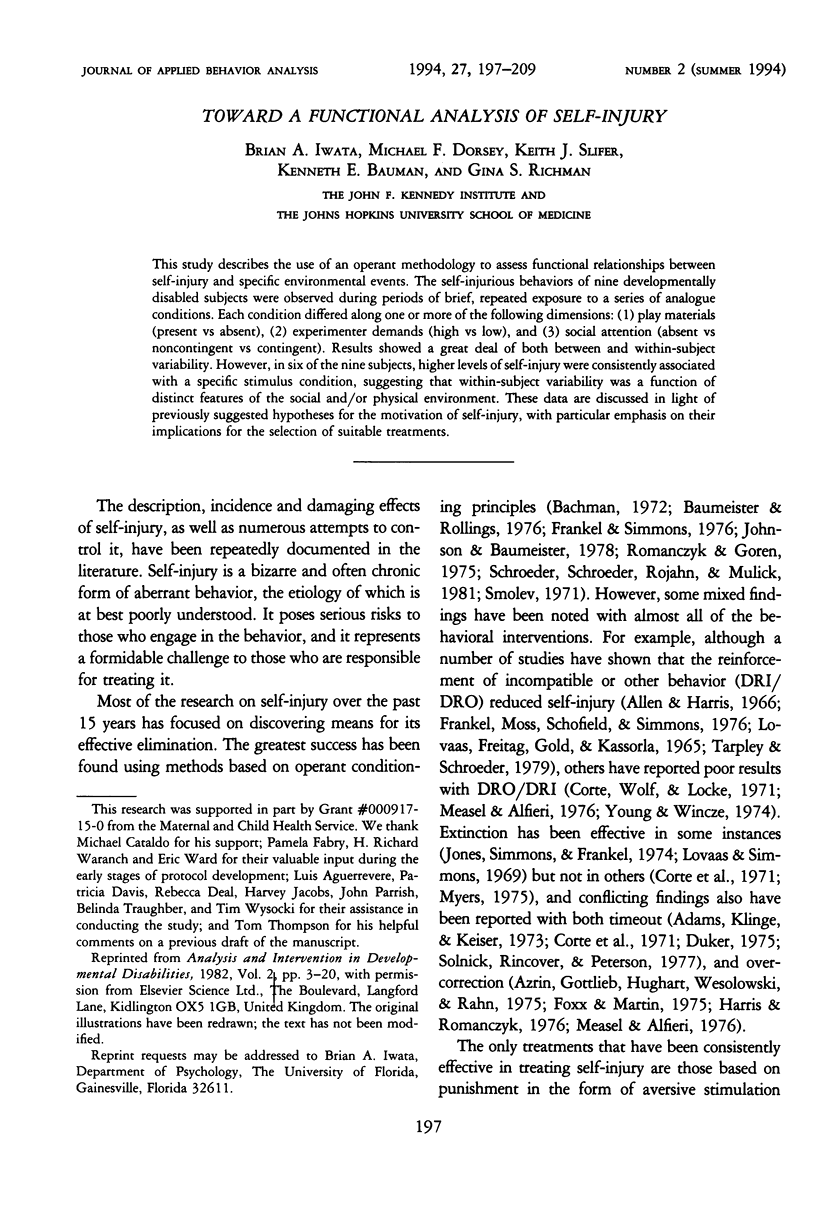
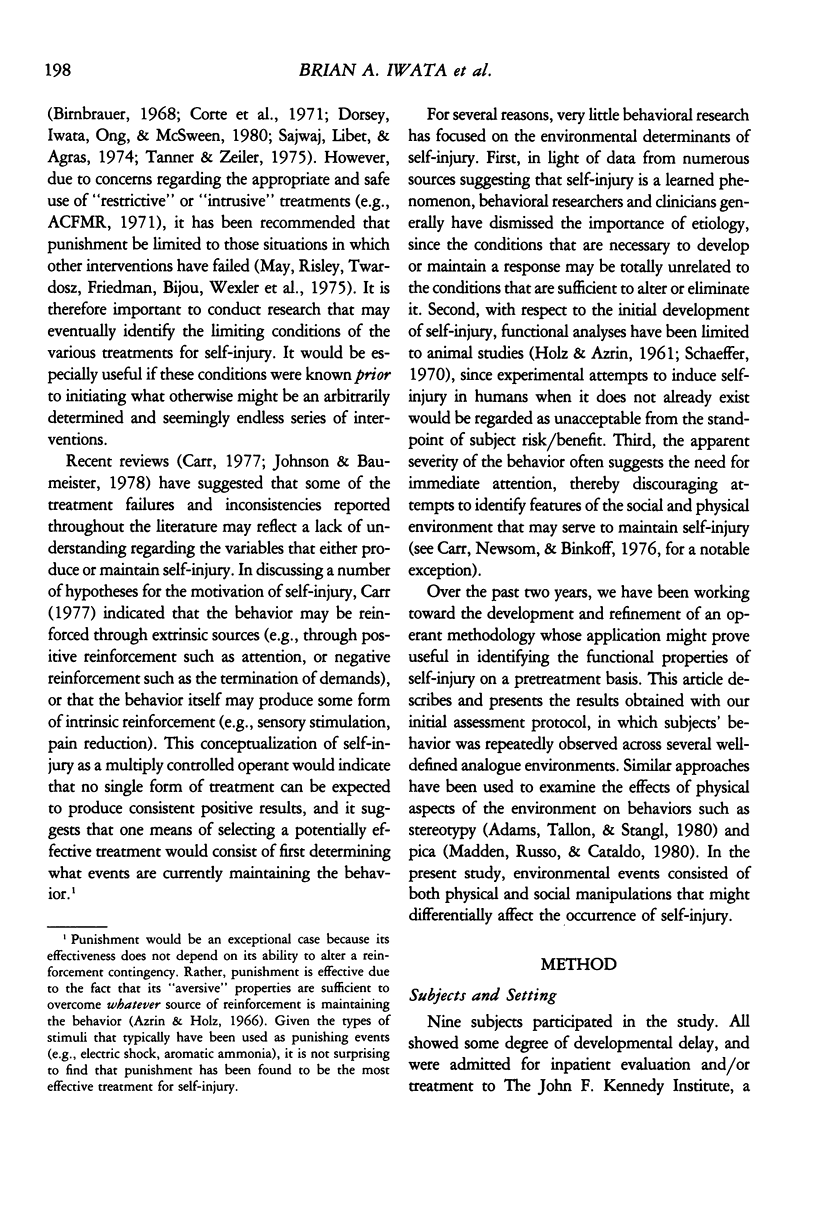
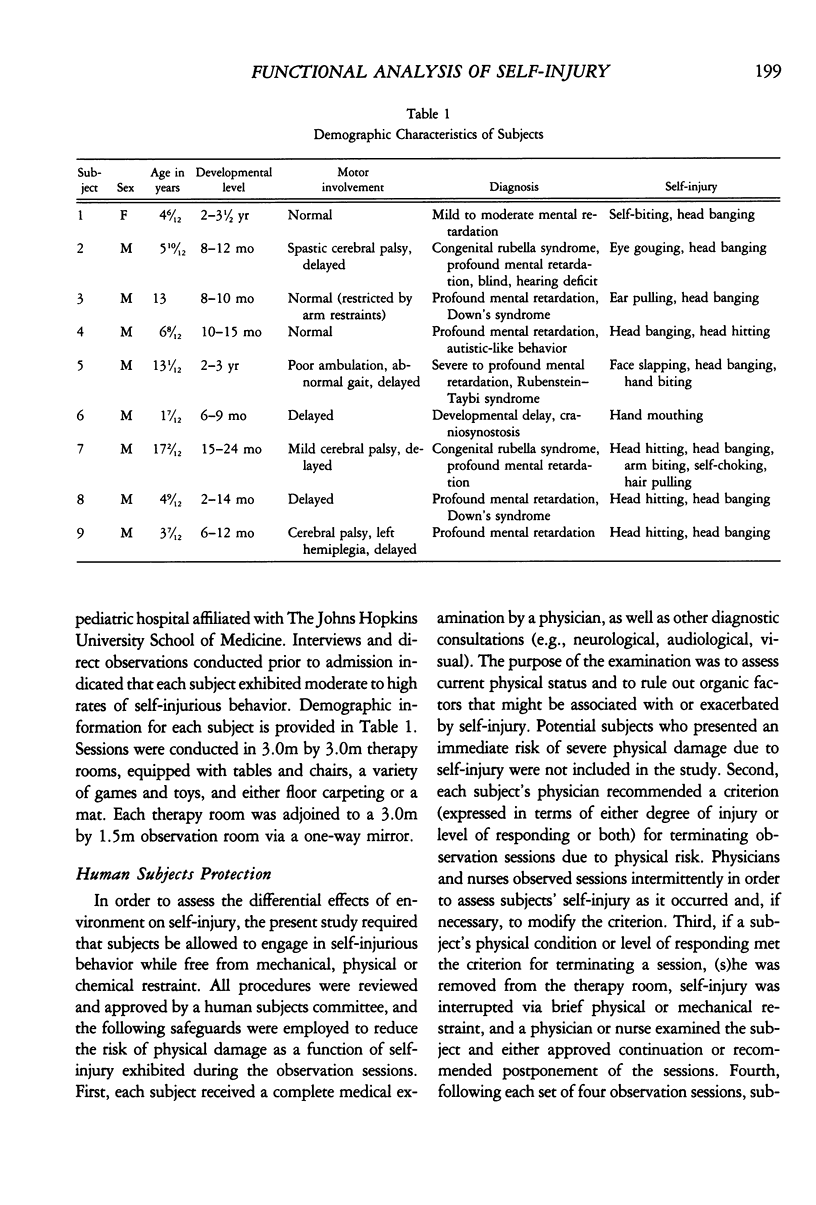
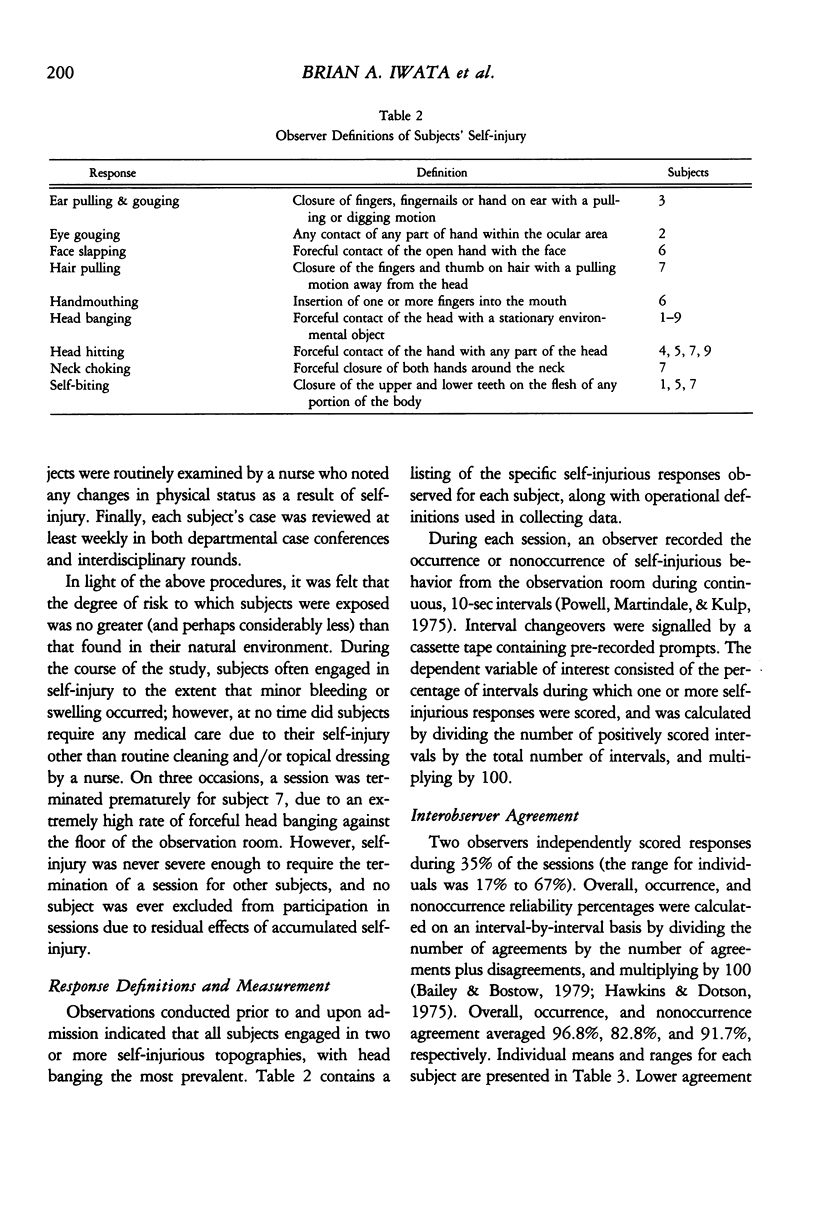
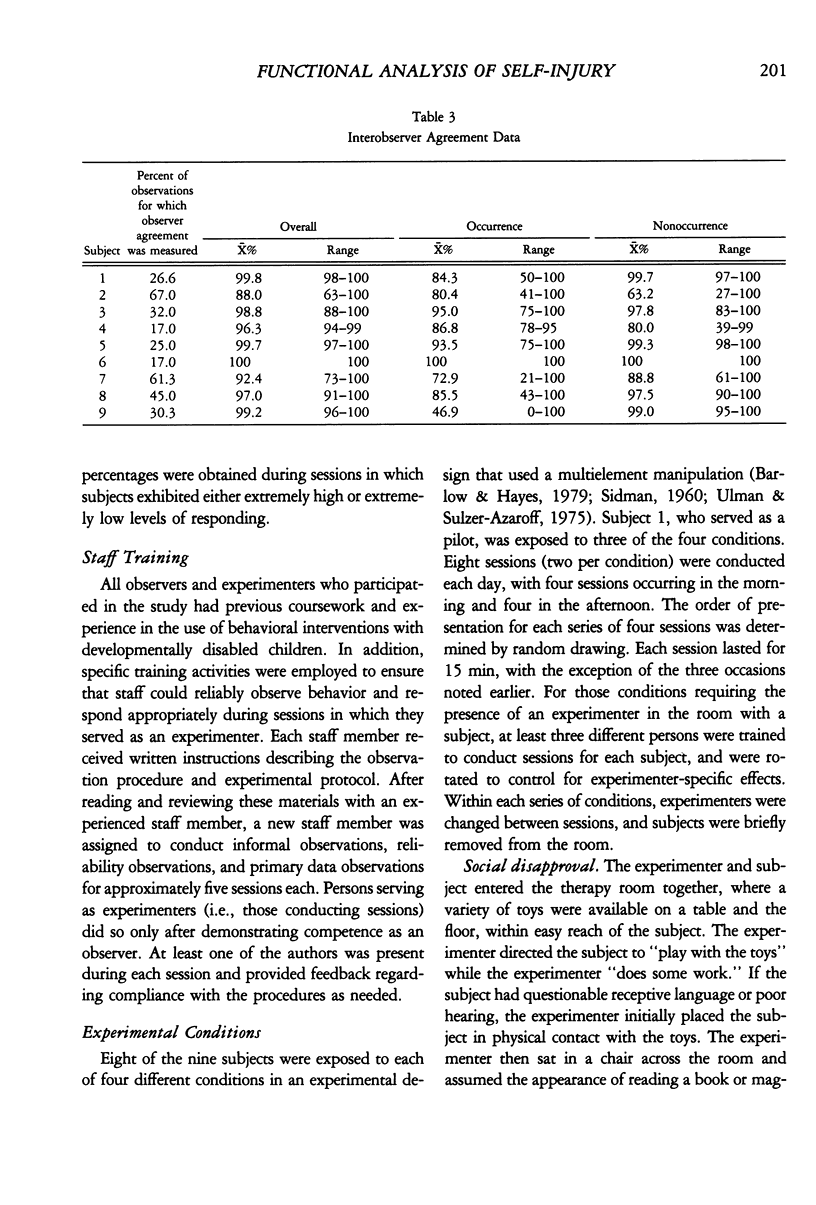
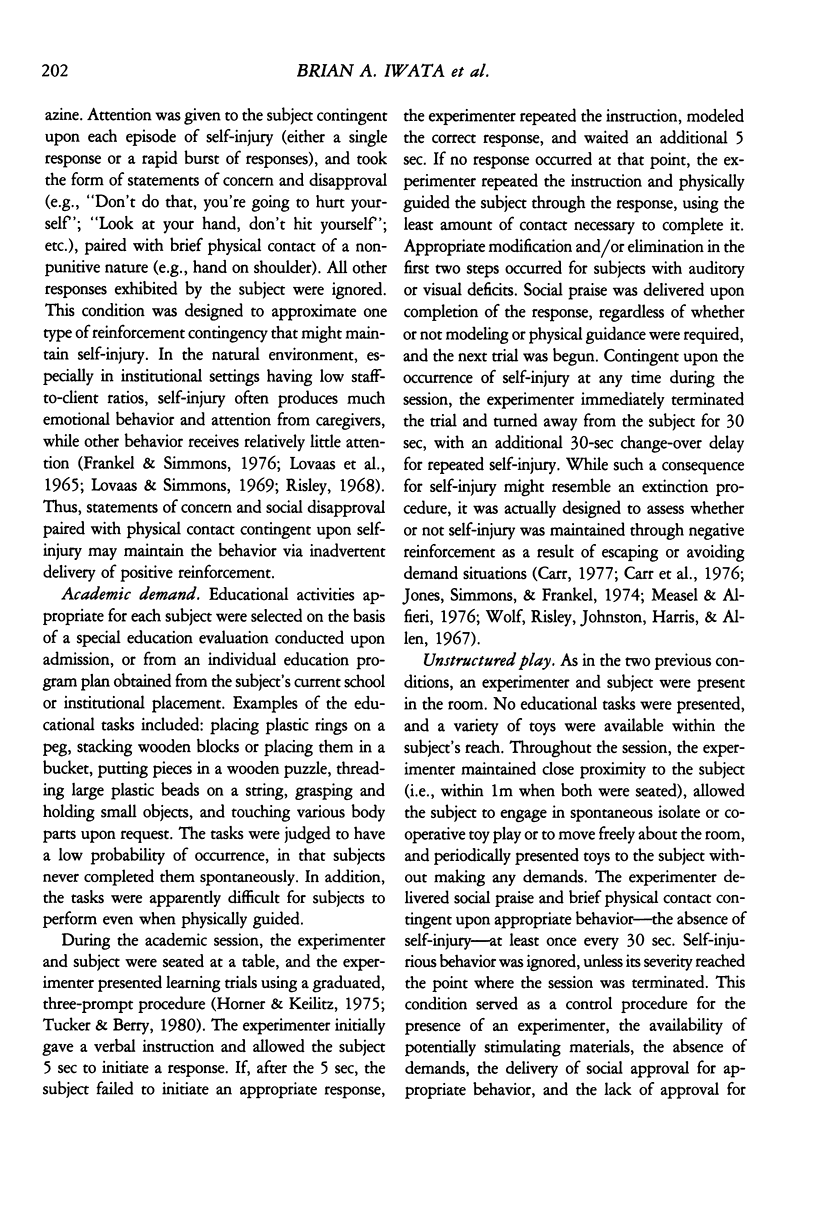
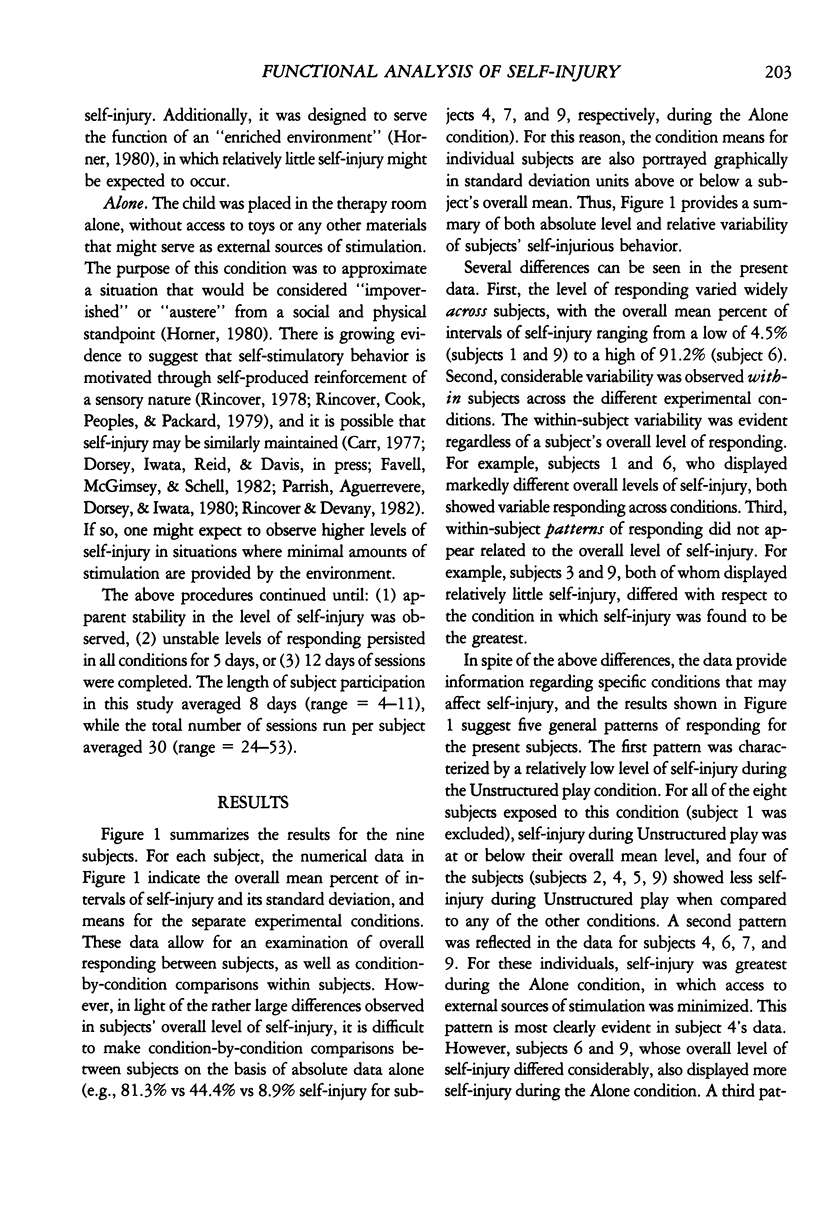
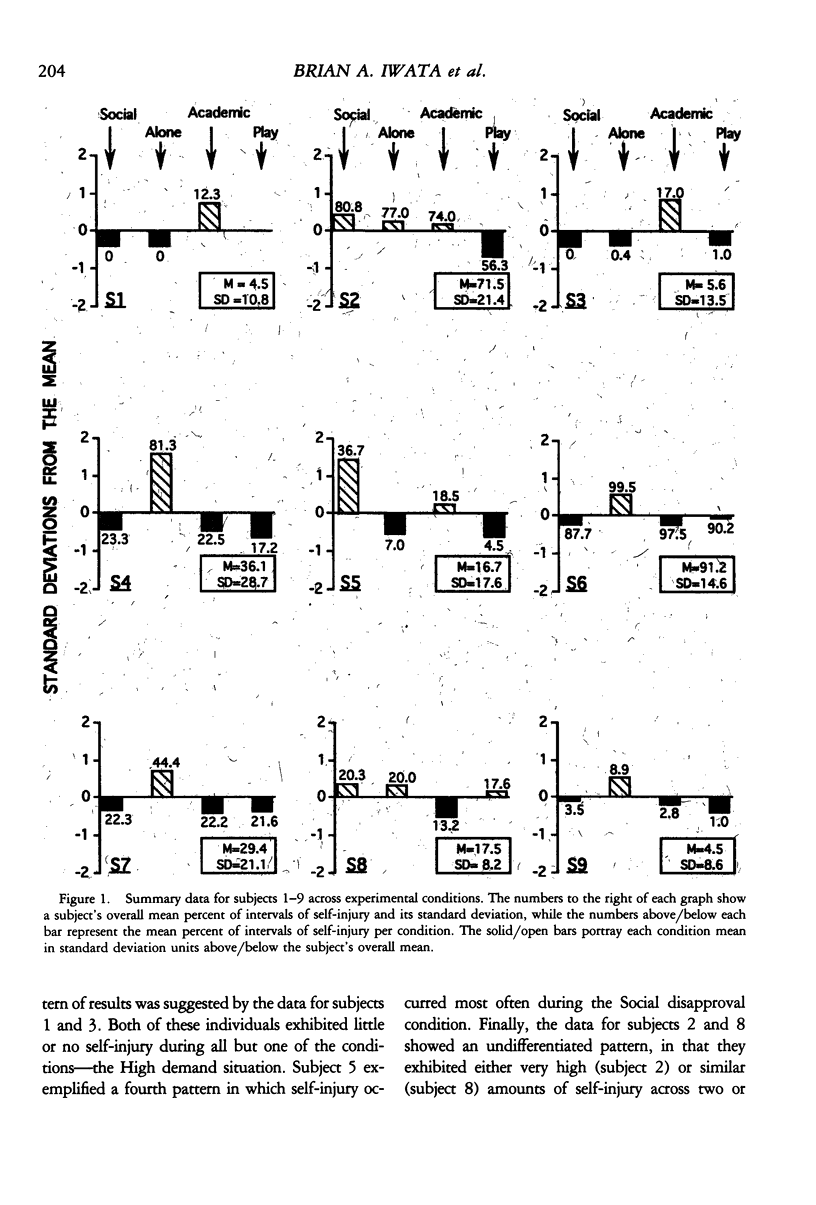
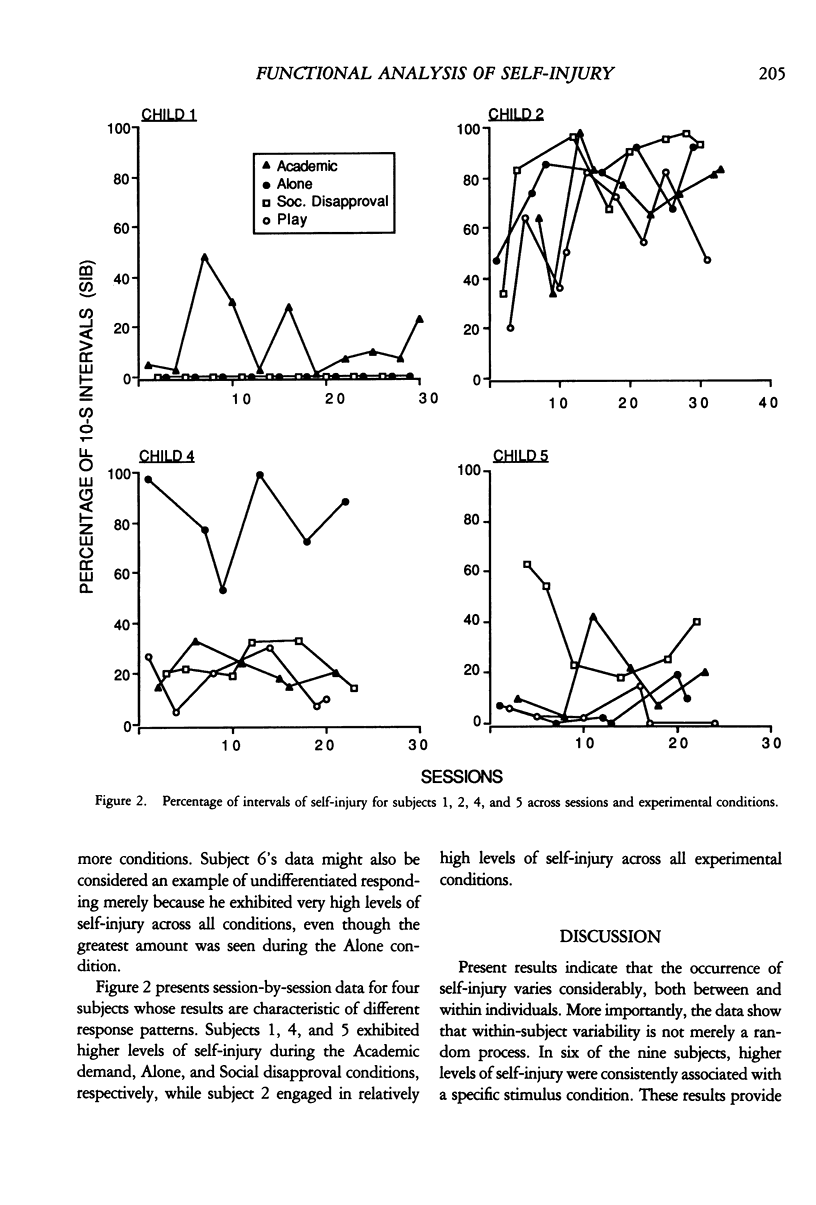

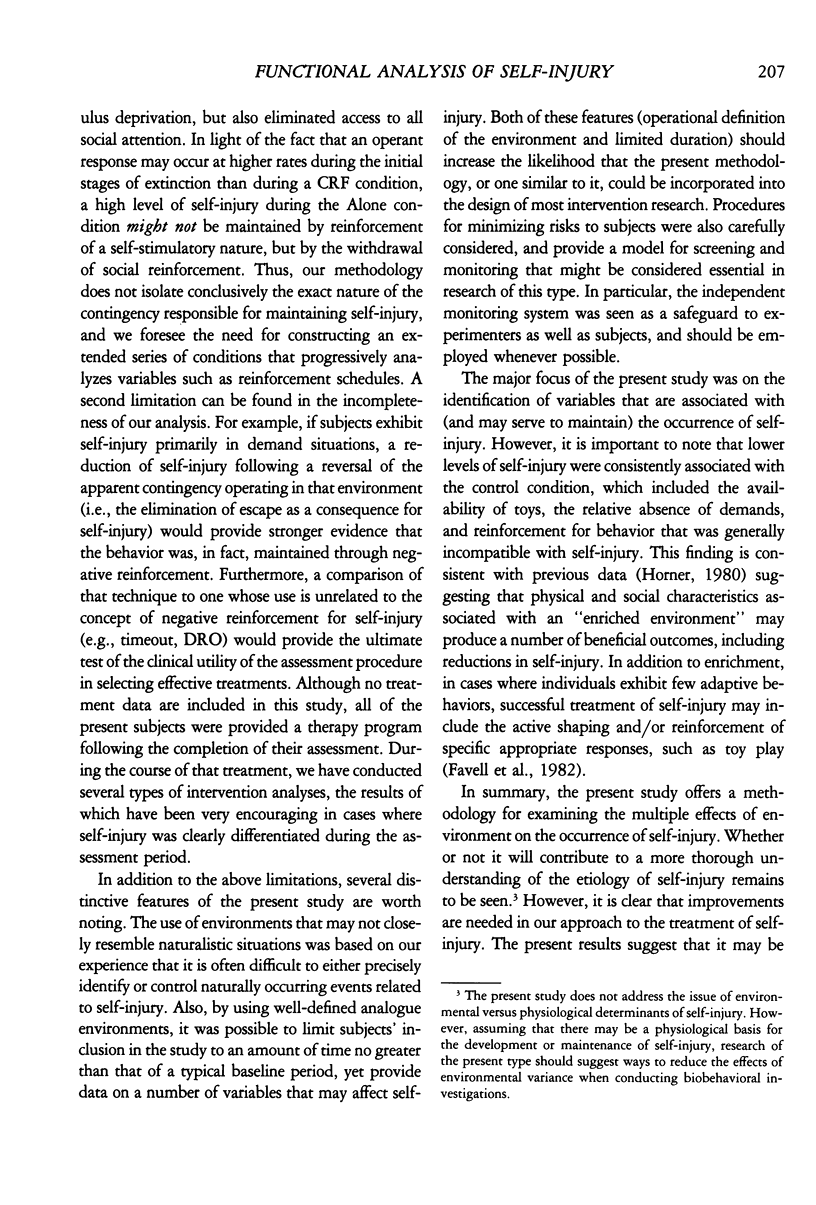
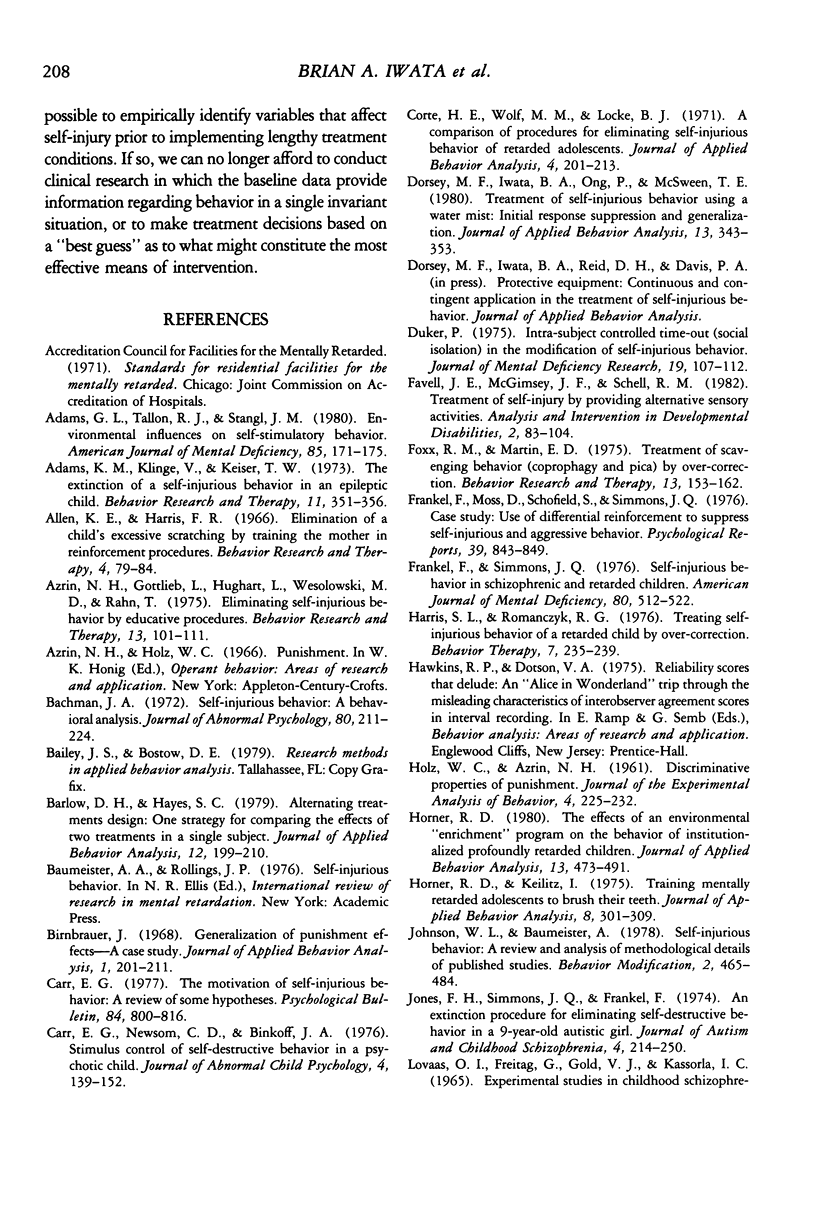
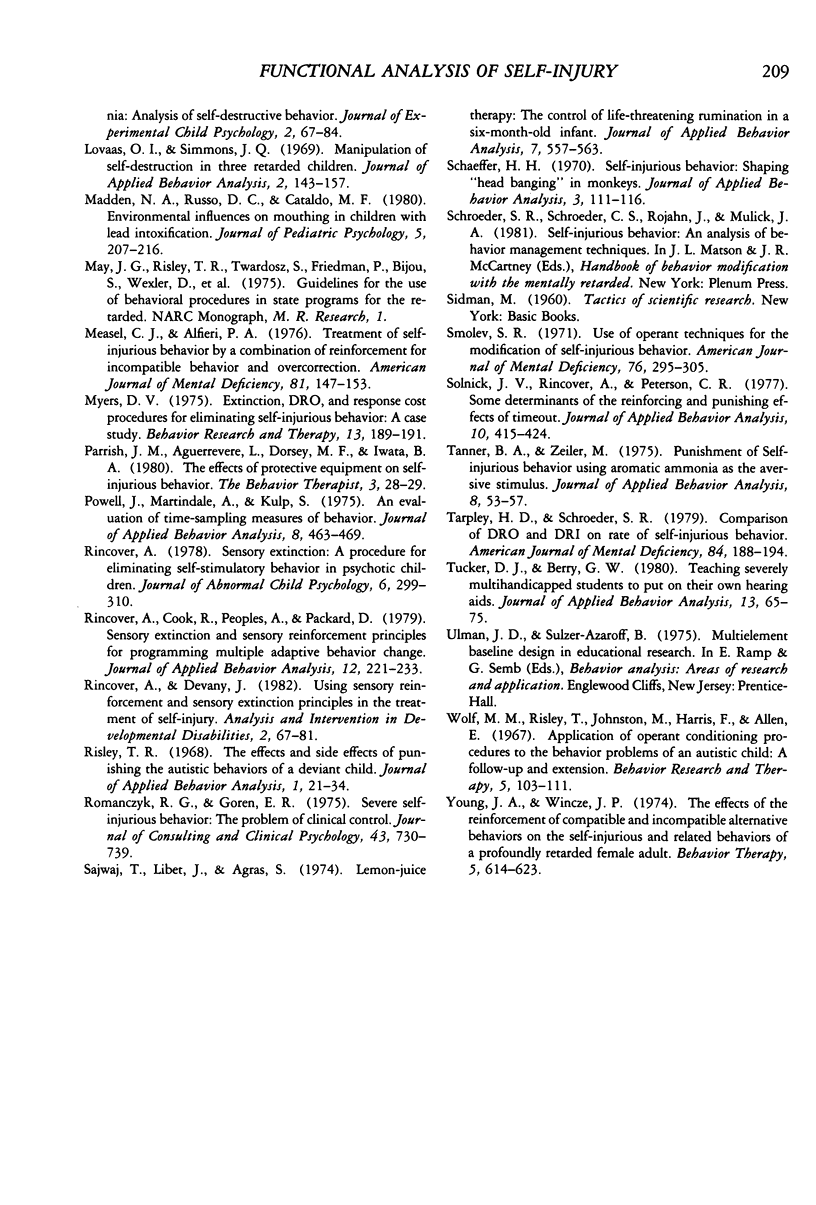
Selected References
These references are in PubMed. This may not be the complete list of references from this article.
- Adams K. M., Klinge V., Keiser T. W. The extinction of a self-injurious behavior in an epileptic child. Behav Res Ther. 1973 Aug;11(3):351–356. doi: 10.1016/0005-7967(73)90017-x. [DOI] [PubMed] [Google Scholar]
- Allen K. E., Harris F. R. Elimination of a child's excessive scratching by training the mother in reinforcement procedures. Behav Res Ther. 1966 May;4(2):79–84. doi: 10.1016/0005-7967(66)90046-5. [DOI] [PubMed] [Google Scholar]
- Azrin N. H., Gottlieb L., Hughart L., Wesolowski M. D., Rahn T. Eliminating self-injurious behavior by educative procedures. Behav Res Ther. 1975 Jun;13(2-3):101–111. doi: 10.1016/0005-7967(75)90004-2. [DOI] [PubMed] [Google Scholar]
- Bachman J. A. Self-injurious behavior: a behavioral analysis. J Abnorm Psychol. 1972 Dec;80(3):211–224. doi: 10.1037/h0033736. [DOI] [PubMed] [Google Scholar]
- Barlow D. H., Hayes S. C. Alternating treatments design: one strategy for comparing the effects of two treatments in a single subject. J Appl Behav Anal. 1979 Summer;12(2):199–210. doi: 10.1901/jaba.1979.12-199. [DOI] [PMC free article] [PubMed] [Google Scholar]
- Birnbrauer J. S. Generalization of punishment effects-a case study. J Appl Behav Anal. 1968 Fall;1(3):201–211. doi: 10.1901/jaba.1968.1-201. [DOI] [PMC free article] [PubMed] [Google Scholar]
- Carr E. G., Newsom C. D., Binkoff J. A. Stimulus control of self-destructive behavior in a psychotic child. J Abnorm Child Psychol. 1976;4(2):139–153. doi: 10.1007/BF00916518. [DOI] [PubMed] [Google Scholar]
- Carr E. G. The motivation of self-injurious behavior: a review of some hypotheses. Psychol Bull. 1977 Jul;84(4):800–816. [PubMed] [Google Scholar]
- Corte H. E., Wolf M. M., Locke B. J. A comparison of procedures for eliminating self-injurious behavior of retarded adolescents. J Appl Behav Anal. 1971 Fall;4(3):201–213. doi: 10.1901/jaba.1971.4-201. [DOI] [PMC free article] [PubMed] [Google Scholar]
- Dorsey M. F., Iwata B. A., Ong P., McSween T. E. Treatment of self-injurious behavior using a water mist: initial response suppression and generalization. J Appl Behav Anal. 1980 Summer;13(2):343–353. doi: 10.1901/jaba.1980.13-343. [DOI] [PMC free article] [PubMed] [Google Scholar]
- Duker P. Intra-subject controlled time-out (social isolation) in the modification of self-injurious behaviour. J Ment Defic Res. 1975 Jun;19(2):107–112. doi: 10.1111/j.1365-2788.1975.tb01263.x. [DOI] [PubMed] [Google Scholar]
- Foxx R. M., Martin E. D. Treatment of scavenging behavior (coprophagy and pica) by overcorrection. Behav Res Ther. 1975 Jun;13(2-3):153–162. doi: 10.1016/0005-7967(75)90009-1. [DOI] [PubMed] [Google Scholar]
- Frankel F., Moss D., Schofield S., Simmons J. Q. Case study: use of differential reinforcement to suppress self-injurious and aggressive behavior. Psychol Rep. 1976 Dec;39(3):843–849. doi: 10.2466/pr0.1976.39.3.843. [DOI] [PubMed] [Google Scholar]
- Frankel F., Simmons J. Q., 3rd Self-injurious behavior in schizophrenic and retarded children. Am J Ment Defic. 1976 Mar;80(5):512–522. [PubMed] [Google Scholar]
- HOLZ W. C., AZRIN N. H. Discriminative properties of punishment. J Exp Anal Behav. 1961 Jul;4:225–232. doi: 10.1901/jeab.1961.4-225. [DOI] [PMC free article] [PubMed] [Google Scholar]
- Horner R. D., Keilitz I. Training mentally retarded adolescents to brush their teeth. J Appl Behav Anal. 1975 Fall;8(3):301–309. doi: 10.1901/jaba.1975.8-301. [DOI] [PMC free article] [PubMed] [Google Scholar]
- Horner R. D. The effects of an environmental "enrichment" program on the behavior of institutionalized profoundly retarded children. J Appl Behav Anal. 1980 Fall;13(3):473–491. doi: 10.1901/jaba.1980.13-473. [DOI] [PMC free article] [PubMed] [Google Scholar]
- Jones F. H. An extinction procedure for eliminating self-destructive behavior in a 9-year-old autistic girl. J Autism Child Schizophr. 1974 Sep;4(3):241–250. doi: 10.1007/BF02115230. [DOI] [PubMed] [Google Scholar]
- Lovaas O. I., Simmons J. Q. Manipulation of self-destruction in three retarded children. J Appl Behav Anal. 1969 Fall;2(3):143–157. doi: 10.1901/jaba.1969.2-143. [DOI] [PMC free article] [PubMed] [Google Scholar]
- Madden N. A., Russo D. C., Cataldo M. F. Environmental influences on mouthing in children with lead intoxication. J Pediatr Psychol. 1980 Jun;5(2):207–216. doi: 10.1093/jpepsy/5.2.207. [DOI] [PubMed] [Google Scholar]
- Measel C. J., Alfieri P. A. Treatment of self-injurious behavior by a combination of reinforcement for incompatible behavior and overcorrection. Am J Ment Defic. 1976 Sep;81(2):147–153. [PubMed] [Google Scholar]
- Myers D. V. Extinction, DRO, and response-cost procedures for eliminating self-injurious behavior: a case study. Behav Res Ther. 1975 Jun;13(2-3):189–191. doi: 10.1016/0005-7967(75)90016-9. [DOI] [PubMed] [Google Scholar]
- Powell J., Martindale A., Kulp S. An evaluation of time-sample measures of behavior. J Appl Behav Anal. 1975 Winter;8(4):463–469. doi: 10.1901/jaba.1975.8-463. [DOI] [PMC free article] [PubMed] [Google Scholar]
- Rincover A., Cook R., Peoples A., Packard D. Sensory extinction and sensory reinforcement principles for programming multiple adaptive behavior change. J Appl Behav Anal. 1979 Summer;12(2):221–233. doi: 10.1901/jaba.1979.12-221. [DOI] [PMC free article] [PubMed] [Google Scholar]
- Rincover A. Sensory extinction: a procedure form eliminating self-stimulatory behavior in developmentally disabled children. J Abnorm Child Psychol. 1978 Sep;6(3):299–310. doi: 10.1007/BF00924733. [DOI] [PubMed] [Google Scholar]
- Risley T. R. The effects and side effects of punishing the autistic behaviors of a deviant child. J Appl Behav Anal. 1968 Spring;1(1):21–34. doi: 10.1901/jaba.1968.1-21. [DOI] [PMC free article] [PubMed] [Google Scholar]
- Romanczyk R. G., Goren E. R. Severe self-injurious behavior: the problem of clinical control. J Consult Clin Psychol. 1975 Oct;43(5):730–739. doi: 10.1037//0022-006x.43.5.730. [DOI] [PubMed] [Google Scholar]
- Sajwaj T., Libet J., Agras S. Lemon-juice therapy: the control of life-threatening rumination in a six-month-old infant. J Appl Behav Anal. 1974 Winter;7(4):557–563. doi: 10.1901/jaba.1974.7-557. [DOI] [PMC free article] [PubMed] [Google Scholar]
- Schaefer H. H. Self-injurious behavior: shaping "head banging" in monkeys. J Appl Behav Anal. 1970 Summer;3(2):111–116. doi: 10.1901/jaba.1970.3-111. [DOI] [PMC free article] [PubMed] [Google Scholar]
- Smolev S. R. Use of operant techniques for the modification of self-injurious behavior. Am J Ment Defic. 1971 Nov;76(3):295–305. [PubMed] [Google Scholar]
- Solnick J. V., Rincover A., Peterson C. R. Some determinants of the reinforcing and punishing effects of timeout. J Appl Behav Anal. 1977 Fall;10(3):415–424. doi: 10.1901/jaba.1977.10-415. [DOI] [PMC free article] [PubMed] [Google Scholar]
- Tanner B. A., Zeiler M. Punishment of self-injurious behavior using aromatic ammonia as the aversive stimulus. J Appl Behav Anal. 1975 Spring;8(1):53–57. doi: 10.1901/jaba.1975.8-53. [DOI] [PMC free article] [PubMed] [Google Scholar]
- Tarpley H. D., Schroeder S. R. Comparison of DRO and DRI on rate of suppression of self-injurious behavior. Am J Ment Defic. 1979 Sep;84(2):188–194. [PubMed] [Google Scholar]
- Tucker D. J., Berry G. W. Teaching severely multihandicapped students to put on their own hearing aids. J Appl Behav Anal. 1980 Spring;13(1):65–75. doi: 10.1901/jaba.1980.13-65. [DOI] [PMC free article] [PubMed] [Google Scholar]
- Wolf M., Risley T., Johnston M., Harris F., Allen E. Application of operant conditioning procedures to the behavior problems of an autistic child: a follow-up and extension. Behav Res Ther. 1967 May;5(2):103–111. doi: 10.1016/0005-7967(67)90004-6. [DOI] [PubMed] [Google Scholar]


